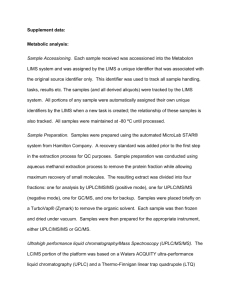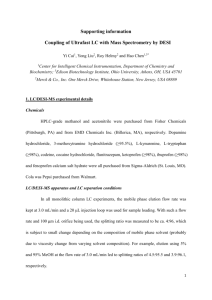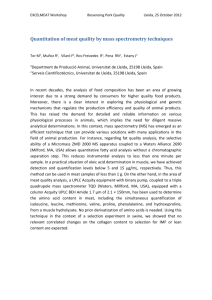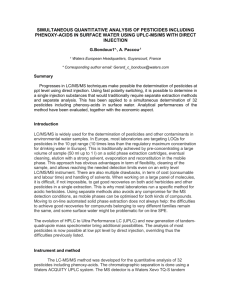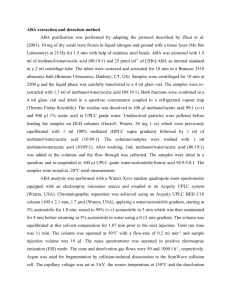20110128_UPLC review - International Journal of Advances in
advertisement
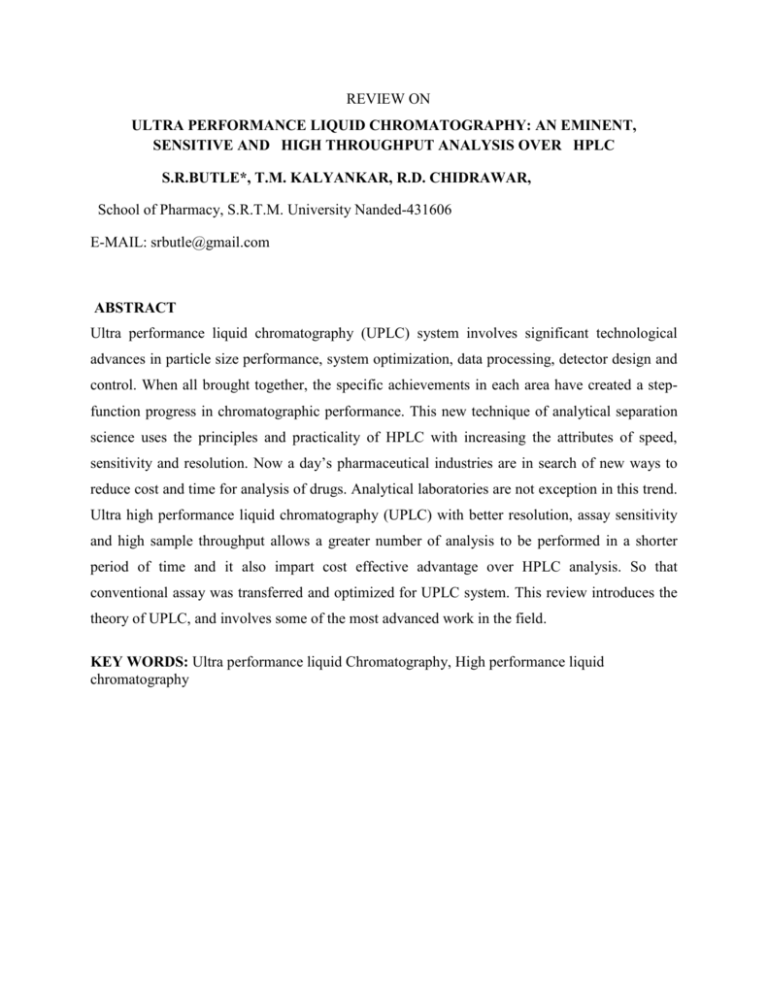
REVIEW ON ULTRA PERFORMANCE LIQUID CHROMATOGRAPHY: AN EMINENT, SENSITIVE AND HIGH THROUGHPUT ANALYSIS OVER HPLC S.R.BUTLE*, T.M. KALYANKAR, R.D. CHIDRAWAR, School of Pharmacy, S.R.T.M. University Nanded-431606 E-MAIL: srbutle@gmail.com ABSTRACT Ultra performance liquid chromatography (UPLC) system involves significant technological advances in particle size performance, system optimization, data processing, detector design and control. When all brought together, the specific achievements in each area have created a stepfunction progress in chromatographic performance. This new technique of analytical separation science uses the principles and practicality of HPLC with increasing the attributes of speed, sensitivity and resolution. Now a day’s pharmaceutical industries are in search of new ways to reduce cost and time for analysis of drugs. Analytical laboratories are not exception in this trend. Ultra high performance liquid chromatography (UPLC) with better resolution, assay sensitivity and high sample throughput allows a greater number of analysis to be performed in a shorter period of time and it also impart cost effective advantage over HPLC analysis. So that conventional assay was transferred and optimized for UPLC system. This review introduces the theory of UPLC, and involves some of the most advanced work in the field. KEY WORDS: Ultra performance liquid Chromatography, High performance liquid chromatography INTRODUCTION High performance liquid chromatography (HPLC) has proven to be the predominant technology used in laboratories worldwide during the past 30-plus years for various pharmaceutical product analyses. One of the primary promoters for the growth of this technique has been the evolution of packing particle size, which is one of the variables used to investigate chromatographic performance of pharmaceutical product. The “need for speed” has been driven due to large numbers of samples that comes particularly in drug discovery and analytical laboratory.(1) The pharmaceutical industry is under intense pressure to increase productivity and put new drugs onto the market in a shorter period of time. Analytical chemists are challenged to find faster ways of delivering quality data across a range of project needs. A number of approaches are being employed to increase separation throughput. (2) A new tool for meeting these challenges became generally available in 2004. This new class of separation science is Ultra Performance Liquid Chromatography (UPLC). Which provides improved resolution, speed, and sensitivity and this is achieved through the use of small columns with very undersized particles packing. By using conventional particle sizes, speed, pressures and peak capacity (number of peaks resolved per unit time) can be extended to new limits and compromises with sacrificing retention time. As the particle size is 1.7µm there is a significant gain in efficiency along with resolution and without diminish efficiency, An elevated temperature having the dual advantages of lowering viscosity and increasing mass transfer by increasing the diffusivity of the analytes, has also been investigated.(3) Now a day’s there is increasing demand for greater pharmaceutical analysis throughput testing by UPLC. An UPLC operates at higher pressure (upto15000psi) and with detector enable to show signal at high data rates. In case of fast eluting peaks in conjunction with new needle design UPLC shows substantially reduce in carryover of sample which is the aids for lowering of limits of quantitation (LOQ). An HPLC method for quality control was optimized to UPLC have attributes to reduce total run time, lower cost per assay and promote instrument uptime. (4) The challenges in developing a new chromatographic particle for analyte separations are described here along with that are more mechanically and chemically stable. Additionally, several new bonded phases provide flexibility during methods development, at variable PH range that enable the initiation of new products to be brought to market faster. A method development by UPLC simultaneously provides full compatibility between chemistry and instrumentation. It is essential to consider the key parameters that influence peak resolution and ultimately lead to successful chromatographic methods. The UPLC from Waters Corporation is the first commercially available system that shows the challenge of using elevated pressures and sub-2 µm particles, which makes it a particularly attractive and promising tool for fast LC method development.(5) Pharmaceutical separations may depend on three categories, that is high throughput, high productivity, and high resolution, these categories give specific pharmaceutical applications, each of which has discrete separation goals. Thus UPLC has provided a new potential for method development and analysis. (6) In recent scenario this technology has been applied to the study of in vivo drug metabolism, particularly during the analysis of drug metabolites in bile, plasma and urine. The reduction in peak width significantly increases analytical sensitivity by three to five-folds and concomitant increase in peak capacity, significantly reduces spectral overlap resulting in superior spectral quality in both LCMS and LCMS/MS modes. The application of UPLC/MS resulted in the detection of additional drug metabolites, superior separation and improved spectral quality. (7) PRINCIPLE The UPLC is based on the principal of HPLC. It involves stationary phase consisting of particles sub 2 μm, as HPLC columns are typically filled with particles of 3 to 5 μm. According to Van Deemter equation, smaller particles provide not only increased efficiency, but also the ability to do work at increased linear velocity without a loss of efficiency, providing both resolution and speed. Efficiency is the primary separation parameter behind UPLC since it relies on the same selectivity and retentivity as HPLC. In the fundamental resolution equation (8) resolution is proportional to the square root of N. 𝑅𝑠 = ĸ √𝑁 𝛼−1 ( 𝛼 ) (ĸ+1) 4 Where N is number of theoretical plates, α is Selectivity factor and k is mean retention factor. But since N is inversely proportional to particle size (dp); 𝑁∝ 1 𝑑𝑝 As the particle size is lowered by thrice i.e. from 5 mm to 1.7 mm, N is increased by three and the resolution by square root of three i.e. 1.7. N is also inversely proportional to the square of the peak width. 𝑁∝ 1 𝜔2 This illustrates that the narrower the peaks they are easy to separate from each other. Also peak height is inversely proportional to the peak width (w): 1 𝐻∝𝜔 So as the particle size decreases to increase N and subsequently Rs, an increase in sensitivity is obtained, since Narrower peaks also mean more peak capacity per unit time in gradient separations, desirable for many applications such as natural extracts, peptide maps etc. Still another equation comes in to force from the Van Deemter plot when moving toward smaller particles: 1 𝐹𝑜𝑝𝑡 ∝ 𝑑𝑝 As particle size decreases, the optimum flow rate (Fopt) reaches to maximum N. But since back pressure is proportional to flow rate, smaller particle sizes require much higher operating pressure and a system properly designed for the same. Higher resolution and efficiency can be level further when analysis speed is the primary objective. Efficiency is proportional to column length and inversely proportional to the particle size: 𝐿 𝑁 ∝ 𝑑𝑝 Therefore the column can be shortened by the same factor as the particle size without loss of resolution. Using a flow rate three times higher due to smaller particles and shortening the column by one third, the separation is completed in 1/9th the time while maintaining resolution (9) CHEMISTRY OF COLUMNS Column researchers and manufacturers have encountered need with the development of more efficient and more reliable packing materials. One of the areas in which improvements have been made is the particle size reduction. According to chromatographic theory, column efficiency (N) is inversely proportional to particle size (dp). Thus, smaller particles provide higher resolution and lower retention time. Fig. 1 Van Deemter plot shows the evolution of particle sizes over the last three decades. In the early 1970s showed that the influence of the particle size of silica gel on column efficiency. This involves the use of smaller particles size resulted in more efficient columns. At that juncture all scientists were used irregularly shaped particles. (10) Following are the companies which gives involvement in development of columns chemistry, performance and high throughput analysis. Waters and company: They launched the XTerra family of HPLC columns featuring first generation hybrid particle technology (HPT). This involves inorganic (silica) and organic (polymeric) packings combined to produce a material that has superior mechanical strength, efficiency and low pH range. As these attributes are necessary for UPLC technology because speed, sensitivity and resolution capabilities of peak depends on these parameter. Therefore, a new pressure bearable and wide pH range particle had been created. A second-generation hybrid column designed to work at higher pressures with the ACQUITY UPLC system. The silica–organic hybrid chemistry is based upon bridged ethylene groups within a silica gel particle structure which gives mechanical strength and pH range from pH 1 to pH 12. As compared to the first generation methyl hybrid particle of XTerra® columns and the bridged ethyl hybrid particle of ACQUITY UPLC BEH columns exhibits improved efficiency, strength and pH range. As BEH Technology is a key enabler of the speed, sensitivity and resolution of UPLC separations. The highly efficient 1.7 μm BEH particles allow chromatographers to maximize the efficiency by increasing theoretical plates (N) of their analyte separation, when it used with the ACQUITY UPLC system, it gives improvement in the selectivity or retentivity (k) and resolution. In order to get the desired separation UPLC BEH columns were carefully chosen BEH C18, C8, Shield RP18 and Phenyl column chemistries these enable the rapid development and more robust separations. Agilent Technologies: The Company provides regular phases with 1.8 μm version particle size. Phases include Zorbax stable Bond C8 and C18 for low-pH operation, Zorbax XDB-C8 and C18 for general-purpose separations, Zorbax Extend C18 for high-pH applications and Zorbax-SB CN which provides a different reversed-phase polarity. These involve both cartridges and standard compression fitting hardware in 2.1, 3.0 and 4.6 mm internal diameters with column lengths of 15–100 mm. In relative to other sub-2 μm columns, pressure drops are reduced by purposely widening the particle size distribution without influencing column efficiency. (11) Alltech Associate: The Company offers a 1.5 μm particle version for their regular columns. The company provides Platinum HPLC columns have controlled surfaces that offer dual mode separations and extend the range of polar selectivity. The C8, C18 and extended polar selectivity (EPS) phases are available in 33 and 53 mm × 7 mm columns in the Rocket form. These are silica-based columns with a 100 A0 pore size which are most enable for small-molecule separations. The Alltima HP HILIC and ProSphere HP ZAP C18 were used in large scale. The former nonbonded, high-purity bare silica column is recommended for the hydrophilic interaction chromatography (HILIC) separations of highly polar compounds that are poorly retained or unretained on conventional reversed-phase columns. These columns are used with mobile phases consisting of mostly organic solvents with only small amounts of water in the mobile phase and are useful in LC–mass spectrometry (MS) for higher sensitivity with volatile mobile phases. For MS, a smaller 2.1 mm i.d. column is available. Columns of 10, 20 and 33 mm lengths are provided. The ProSphere column has a 500 A0 pore size, which makes it ideal for the high-speed reversed-phase separation of proteins. Bischof firm: The Company offers four columns, first three are porous (1.8 μm) and last one is a nonporous silica phase (1.5μm).The totally porous packings are based upon 300 m2/g silica. The Pronto PEARL sub-2µm, TPP-C8, ACE EPS (8% carbon loading) and C18 EPS (16% carbon) are smaller particle versions of their regular production. Their Column dimensions are 30–50 mm × 2.0 and 4.6 mm. The third phase on totally porous silica is the Pronto PEARL sub-2 TPP APS, which is a reversed phase with a polar-embedded functionality (3.5% carbon content). This packing gives higher retention for acidic compounds compared with C8 and C18 bonded phases. This 1.8 μm column was used to determine the polyphenol content. Relative to the matrix components, the polyphenol were well retained; thus, no extensive sample preparation was required except filtration through a 0.2 μm filter. Types of capillary columns: 1. Packed capillary columns Packed columns are made by padding the capillary with silica-modified particles of 3–5 μm particles of even smaller sizes 1.5–1.8 μm were successfully employed in UPLC. Such a small particle size provides chromatography systems with higher efficiency, resolution, selectivity, and shorter analysis time; but does not increase the back-pressure. Many research labs pack the columns “in-house”. But it is a difficult and skill-demanding process. To ascertain the particles of the same diameter and to avoid undesirable void volumes. The application of packed capillary columns is the most explored option in UPLC. 2. Monolithic Capillary Column Monoliths are a block of continuous materials made of highly porous rods with two types of pore structures (macropores and mesopores of different sizes), which allow the use of higher flow rates and thus reduces the analysis time. Monolithic polymer columns were first used in the late 1980s, but not available until 2000. Presently four types of monolithic capillary columns can be found: particle fixed, silica based, polymer based, and molecular imprinted monolith. Now a day there is not much research information on application of monolithic capillary in UPLC. 3. Open tubular capillary columns In open tubular liquid chromatography column, the capillary wall is coated with highly permeable porous material that serves as the stationary phase. The OT capillary has lower sample loading capacity of the column, because only a small surface area is available for analytes interaction that can result in column overloading causing peak asymmetry and poor efficiency. Future scope in small particle technology. The separation speeds of relatively simple samples by using sub-2 μm porous particle size and shorter columns could result in separations at only a few seconds. The rapid feedback required in on-line process analytical technologies, screening of million-compound libraries in combinatorial chemistry and drug discovery area that might create such a need. In case of higher plate counts longer columns with these smaller particles will be required. Already researcher have demonstrated separations at pressures as high as 7000 bar using nonporous particles with diameters as small as 1 μm packed into nano bore columns (50 μm i.d.) to keep heat generation minimized. Such columns are capable of generating several hundred theoretical plates in minutes. With safety in the routine use of high pressures in the chromatography laboratory is always in a consideration. Nevertheless, the need for further reductions in particle size below the currently available 1.5–1.9 μm particles is required, as manufacturers will respond to provide such columns. Some of the issues surrounding the optimum use of these micrometer-sized particles are the implementation of new column and instrument hardware designs; the development of efficient packing techniques; considerations of particle and packed-column stability; the ability to make stable wide pore packings for the separation of biomolecules. Silica gel-based packings become more friable as the pore size increases. Perhaps some of the techniques used to construct silica-organic hybrids, for the synthesis of highly cross linked polymers, or the use of carbon or other inorganic-based packings could alleviate concerns in packing stability. (12, 13) APPLICATION OF UPLC 1. UPLC with MS UPLC coupled to quadrupole tandem mass spectrometry which operates with rapid, generic gradients and shows increase in analytical throughput and also shows sensitivity in high throughput pharmacokinetics or bioanalysis studies, the rapid measurement of potential p450 inhibition, induction, and drug-drug interactions had been studied by UPLC/MS/MS. As UPLC based approach can helps to the labs pre-emotively and determine candidate toxicity and drug-drug interactions, it enables organizations to be more confident in the viability of candidate medicines that do progress to late-stage clinical trials. The UPLC/ TM technology is based on the use of columns packed with 1.7µm porous particles enabled to improve in peak resolution, sensitivity and speed of analysis. UPLC TM chromatograms shows a very sharp peaks with less than 2 s wide at the base, This enhanced efficiency resulted in an increased separation speed of the whole UPLC TM-MS/MS procedure that required less than 5 min. (14) 2. UPLC in Pharmaceutical Development Now a day’s UPLC is a very attractive tool for the pharmaceutical development laboratory because of high resolution obtained in extremely short period of analysis times, as UPLC provides high throughput, high productivity and high resolution. These categories have specific pharmaceutical applications and distinct separation goals. Now these goals have been achieved by utilizing conventional UPLC with typical column dimensions and particle sizes. The recent introduction of UPLC has provided a new potential for method development and analysis. Pharmaceutical chemists determine the impact of this emerging technology, using sub2 μm particle size column along with increased linear velocities. As mobile phase viscosity must be minimized or the chromatography system must be redesigned to withstand an increased backpressure. Today, there are many commercially available UPLC systems capable of exceeding conventional pressure limits of 400 bars. The advantage of UPLC over conventional HPLC is the capability to increase the speed without sacrificing efficiency. In comparison to traditional HPLC, The research showed that UPLC can decrease run times up to 7×. In addition, for high resolution applications, UPLC achieved significant efficiency advantages over traditional HPLC. 3. UPLC used in Identification of Metabolite Biotransformation of new chemical entities (NCE) is necessary for drug discovery. When a compound reaches the trial stage, metabolite identification is required and it is necessary for lab to successfully detect and identify all circulating metabolites of a contender drug. Discovery studies are generally carried out in vitro to identify major metabolites so that metabolic weak spots on the drug contender molecule can be recognized and protected by changing the compound structure. The key for analysts in metabolite identification is maintaining high sample throughput and providing results to medicinal chemists as soon as they are available. UPLC/MS/MS addresses the complex analytical requirements of biomarker discovery by offering unmatched sensitivity, resolution, dynamic range, and mass accuracy. Tandem quadrupole MS combines with UPLC in ADME screening for sensitivity and selectivity with fast analyses of samples in matrix to be achieved with minimal cleanup, using MRM (multiple reaction monitoring) for detection and automated compound optimization. 4. UPLC used in Bioanalysis / Bioequivalence Studies For Pharmacokinetic, Bioequivalence and toxicity studies, the quantitative analysis of a drug in biological samples is an important part of drug development process and this is carried out by UPLC. The drugs having low molecular weight are tested during both preclinical and clinical studies, as several biological matrices are used for quantitative bioanalysis, the most common being used are the blood, plasma, and urine. (15) The primary technique for quantitative bioanalysis of new entity is LC/MS and the sensitivity and selectivity of UPLC/MS/MS at low detection levels generates accurate and reliable data that can be used for a variety of different purposes, including statistical pharmacokinetics (PK) analysis. UPLC/MS/MS develop a robust and compliant assay which has been traditionally the domain of very experienced analysts. UPLC/MS/MS helps in the method development for bioanalytical products. It helps to determine whether new formulations of existing drugs allow the compound to reach the bloodstream at a similar rate and exposure level as the original formulation.UPLC/MS/MS has proven to increase efficiency, productivity, and profitability at bioequivalence laboratories. An application of UPLC/MS/MS in bioequivalence and bioanalysis gives efficient separations with fast acquisition rates using tandem quadrupole MS systems, which easily acquire report and quantify full system data in a compliant environment. And ensure the highest quality results and reliable system operation in regulated environment. UPLC is sophisticated and integrated system for bioanalysis and bioequivalence studies, providing excellent chromatographic resolution and sensitivity along with multiple reactions monitoring. 5. UPLC used in stressed degradation Studies One of the most important factors that impacts the quality and safety of pharmaceuticals is chemical stability. The FDA and ICH Guideline provide stability testing data to understand how the quality of an API (active pharmaceutical ingredient) or a drug product changes with time under the influence of forced degradation factors such as heat, light, pressure and moisture or humidity. Knowledge of these stability characteristics helps in storage conditions and shelf life, the selection of proper formulations and protective packaging is required for regulatory documentation. Forced degradation, is carried out under even harsher conditions than those used for accelerated stability testing. The test generally performed early in the drug development process, as laboratories cause the potential drug to degrade under a variety of conditions like peroxide oxidation, acid and base hydrolysis, photo stability, and temperature to understand resulting by products and pathways that are necessary to develop stability indicating methods. The most common analytical technique for monitoring forced degradation experiments is HPLC with UV and/or MS detection for peak purity, mass balance, and identification of degradation products but these HPLC-based methodologies are time-consuming and provide only medium resolution to ensure that all of the degradation products are accurately detected. PDA/MS (photodiode array and MS) used along with UPLC, which allows for faster and higher peak capacity separations of complex degradation product profiles. UPLC separations with the high-speed scan rates of UPLC-specific photodiode array and MS detection will give confidence for identifying degradation products and thus shortening the time required to develop stability-indicating methods. 7. UPLC used in Impurity Profiling Impurity profiling is an important task for the drug development and formulation process, which helps in detecting, profiling and quantifying drug substances and their impurities in raw materials and final product. As impurity profiling requires high-resolution chromatography which is capable of reliably and reproducibly separating and detecting all of the known and unknown impurities of the active compound. It is critical assignment to accurately measure low-level impurities at the same time as the higher concentration active pharmaceutical component. This activity, however, can be complicated by the presence of excipients in the sample, often resulting in long HPLC analysis times to achieve sufficient resolution. UPLC system and columns specifically gives high-throughput analysis along with high peak resolution. UPLC PDA detector involves two analytical flow cells with maximum flexibility and according to application requirements, as one for maximum chromatographic resolution and a second for high sensitivity. UPLC also ensure the latest peak detection algorithms and custom calculations to optimize data processing and reporting. It also assertively detects impurities in compounds even at trace levels. To characterize impurities, it is often necessary to perform several analytical runs to obtain the necessary MS and MS/MS data. UPLC combines with exact MS, which operate with alternating low and high collision energies, known as UPLC/MS/MS, which has been successfully employed for the identification of drug and endogenous metabolites. The rapid switching of the collision cell energy produces both precursor and product ions of all of the analytes in the sample while maintaining a sufficient number of data points across the peak for reliable quantification. The sensitivity and flexibility of exact time-of-flight mass spectrometry with alternating collision cell energies, combined with the high resolving power of the UPLC system, allows for the rapid profiling and identification of impurities. 8. UPLC used in Dissolution Testing Dissolution testing is essential in the formulation and development along with production process in association with quality control. In sustained-release and metered release dosage formulations, testing of higher potent drugs is particularly important where dissolution can be the rate-limiting step in medicine delivery. The dissolution profile is used to demonstrate reliability and batch-to-batch uniformity of the active ingredient and dosage form. Additionally, newer and more potent formulations require increased analytical sensitivity. UPLC provides precise and reliable automated online sample acquisition. It automates dissolution testing, from production to test start, a through data acquisition and analysis of sample aliquots is required for the management of test result in publication and distribution. (16) ADVANCES IN UPLC PATROL™ UPLC Process Analyzer Liquid chromatography is a major analytical technique in every QC lab but it is not a major tool for on-line/at-line analysis. As it is too slow process because it requires Long run times along with not rugged enough for continuous operation. It requires Excessive down time and expensive to operation and highly skilled technicians. PATROL™ UPLC process analyzer have “real-time” speed analysis in less than 5 minutes along with user friendly and doesn’t typically require extensive sample handling or sample preparation as during in-process liquid samples which is fully automated, results in multiple chemically-related and unrelated components resolved in a single analysis with broad linear dynamic range with excellent selectivity and sensitivity So as to overcome the problem associated with on time analysis, PATROL™ UPLC process analyzer had been introduced. Fig. 2 Original HPLC Method Too Slow for On-Line Analysis run time 25min. Fig. 3 Transfer of method from HPL C to UPLC and optimization the run time is 30 sec. Fig. 4 PATROL™ UPLC analyzer Fig 5 Chromatograph of on line product analysis Applications of PATROL™ UPLC analyzer PATROL™ UPLC analyzer automatically performs sample dilution as operator introduces sample to this system, during at-line analysis using full barcode level of automation. It analyzes reaction progress and measures concentration of starting material, intermediate, impurities, final product and reaction stopped by analyzer when residual starting material achieved target or impurities reach a threshold value. Nano ACQUITY UPLC It gives the most information from very small amounts of highly complex samples and ideal for proteomics and biomarker discovery. It is designed with nano-scale capillary and narrow-bore separation which allows direct nano-flow to attain the highest chromatographic resolution, sensitivity, and reproducibility. It gives 0.25 minute standard deviation run-to-run reproducibility, even over long gradients which increase reliability and ease of use through holistic design, intuitive diagnostics and customized nano-scale fittings with columns. It incorporates the highest level of separation performance with the benefits of simplicity and ease of use. It allows high sequence coverage and dynamic range for analysis of complex proteomic mixtures and protein identification with nano UPLC column and TRIZAIC nanoTile. It significantly increases sensitivity over HPLC and also used for metabolic profiling studies Nano ACQUITY UPLC provides increased chromatographic performance, resulting in sharper peaks and greater resolution, the increased resolution helps for the shorter analysis time and increased sample sensitivity. It involves three technology 1D, 2D and TRIZAI UPLC with nano tile technology. The flexible 1D, 2D and nano UPLC system shows high chromatographic resolution in both dimensions and increases peak capacity for protein identification along with improved quantification & expression analysis of peptide mapping. ASSAY TRANSFER FOR SIMVASTATIN FROM HPLC TO UPLC Simvastatin is a lipid-lowering agent that derived synthetically from a fermentation product of Aspergillus terreus. This is an inhibitor of 3-hydroxy-3-methylglutarylcoenzymeA (HMG-CoA) reeducates. This enzyme catalyzes the conversion of HMG-CoA to mevalonate, which is an early and rate-limiting step in the biosynthesis of cholesterol. Fig 7 Structure of Simvastatin INSTRUMENTATION CHARACTERISTICS HPLC UPLC PARTICLE SIZE 5 mm 1.7 mm MOBILE PHASE 65%acetonitrile:35%phosphate 65%acetonitrile:35% aqueous buffer, pH 4.5 ANALYTICAL XBridge™ C18 UPLC BEH C18 4.6 x 250 mm, 2.1 x 30 mm, 1.5 mL/min 10 μL 0.56 mL/min 0.8 μL COLUMN COLUMN DIMENSIONS FLOW RATE INJECTION VOLUME Table No. 1 Instrumental condition for Assay of Simvastatin by HPLC and UPLC. Assay performance The UPLC assay selected for use and evaluation, as it yielded the highest throughput with meeting the assay acceptance criteria. The assay reproducibility performance was evaluated using the conditions developed by the UPLC console calculator. The percent RSD for this methodology was determined to be 0.883 for six 0.8 mL replicate injections of the simvastatin standard. These results were well within the USP acceptance criteria for the methodology. The conditions of shortest analysis time were performed as per table no.1 Hence the USP HPLC-UV methodology for the assay of simvastatin has been successfully transferred to an ACQUITY UPLC method. The final methodology reduced the analysis time from analyte retention of 9.28 minutes with HPLC to analyte retention of just 1.41 minutes with UPLC (a seven-fold increase in throughput). It gives maximum efficiency which is the criteria transfer of chromatographic method, when compared to the original HPLC conditions with both the equal and maximum UPLC conditions the USP assay criteria of efficiency, k’ and tailing, were meet or exceeded. The assay reproducibility performance was determined for the equal efficiency method and was found to be less than 1% RSD for six replicate injections. Finally, the assay was transferred to a shortest analysis time method on the ACQUITY UPLC system, which gave an analysis time of 0.3 minutes with an analytes retention of 0.23 minutes, resulting in an increase in throughput of 40-folda and it show that ease of HPLC to UPLC method transferability, where UPLC can significantly increase throughput with quality. (18) System suitability criteria for Simvastatin UPLC method. 1 2 3 4 5 6 Mean Std.Dev. %RSD Injection Peak Name RT Area %Area height 1 2 3 4 5 6 Simvastatin Simvastatin Simvastatin Simvastatin Simvastatin Simvastatin 1.374 1.374 1.375 1.375 1.375 1.375 1.375 0 388681 389533 383973 380276 386983 386800 386041 3410 100 100 100 100 100 100 234823 235199 231690 229737 233379 233178 0.03 0.833 Fig 8 HPLC Assay of Simvastatin. Fig 9 UPLC Assay of Simvastatin using Console Calculator. ADVANTAGES OF UPLC UPLC allows faster laboratory method development with maintaining resolution, selectivity, sensitivity, and dynamic range of LC analysis. As it reduces process cycle times, so that more product can be analyzed with existing resources. It assures quality results with decrease in run time, cost and increases sensitivity of sample analysis along with less solvent consumption. UPLC Increases sample throughput through the use of a novel separation material of very fine particle size and enables manufacturers to produce more material that consistently meet or exceeds the product specifications, potentially eliminating variability, failed batches, or the need to re-work material. It’s fast resolving power quickly quantifies related and unrelated compounds. (19, 20) DISADVANTAGES OF UPLC The performance of UPLC may be similar or even higher that have been demonstrated by using stationary phases of size around 2 μm without the adverse effects of high pressure. The phases of less than 2 μm are generally non-regenerable and thus have limited use as increased pressure it requires more maintenance and reduces the life of the columns. (21, 22) CONCLUSION It has been revealed that UPLC has great potential to be widely employed for impurity/degradation profiling applications, as well as other development applications. As UPLC increases productivity in both chemistry and instrumentation by providing more information per unit of work as it gives increased resolution, speed, and sensitivity for liquid chromatography. When researcher experience separation barriers with conventional HPLC, UPLC extends the utility of chromatography. The main advantage of UPLC is a reduction of analysis time, along with reduced solvent consumption, high throughput analysis and reduction in cost of analysis. Overall, it appears that UPLC can put forward significant improvements in speed, sensitivity and resolution compared with conventional HPLC. REFERENCES 1. Swartz ME. UPLC: An Introduction and Review. J Liq Chrom. 2005; 28:1253-1263. 2. King, Salane; Stoffolano, Peter J. Robinson, Eric The evaluation and application of UPLC For the rapid analysis of dose formulations. LC-GC North America.2005;1-5. 3. E. S. Grumbach, T.E. Wheat, M. Kele and J. R. Mazzeo; LC-GC. Chromatographyonline. 2005; 15:1-5. 4. A.D. Jerkovich, J.S. Mellors, and J.W. Jorgenson. LCGC. 2003; 21(7), 600–610. 5. A. D. Jerkovich, R. LoBrutto, and R. V.Vivilecchia.;LC-GC.chromatographyonline.2005; 40, 1-4 6. S.M. Chesnut, J. J. Salisbury. WILEY-VCH Verlag GmbH; 2007; 1-4. 7. Plumb R, Castro-Perez J, Granger J, Beattie I, Joncour K, Wright A. Ultra-performance liquid chromatography couple to quadrupole-orthogonal time-of-flight mass spectrometry. Rapid Commun Mass Spectrum. 2004; 18; 2331-2338. 8. Skoog DA, Holler FJ, Nieman TA. An introduction to chromatographic separations. Principals of instrumental analysis. 5th ed. Florida: Saunders College publishing, 1998; 674-697. 9. Kondawar M. S, Patil S.B. Ultra Performance Liquid Chromatography: A Faster and Sensitive Method over HPLC; DOA Journal, 2006; 4, 5. 10. R.E. Majors, J. Chromatogr. Sci., 1973; 11, 88–95. 11. W.E. Barber, A. Broske and T. Langlois, "Influence of particle size distribution on HPLC column HETP and operating pressure: Design implications for very small particle packings, which generate high pressures," HPLC 2005, Stockholm, Sweden, 5:04. 12. Y. Xiang, D.R. Maynes and M.L. Lee, J. Chromatogr. A, 2003; 991, 189–196. 13. Ronald E. Majors, J. Chromatogr. Sci, Europe, 1973; 19, 6. 14. Milagros Mezcua, Ana Ag¨uera, Josep Llu´ıs Lliberia, J of Chromatogr A, 2006; 1-6. 15. Goodwin L, White SA, Spooner N. Evaluation of ultra-performance liquid chromatography in the bioanalysis of small molecule drug candidates in plasma. J. Chromatogr. Sci.; 2007; 45(6): 298–304. 16. B. Srivastava, B. K. Sharma, Uttam Singh Baghel, Ultra Performance Liquid Chromatography: A Chromatography Technique International Journal of Pharmaceutical Quality Assurance 2010; 2(1): 19-25. 17. www.water.com/ Expand Your Horizons with UPLC® Technology. 18. Paul Rainville and Robert Plumb Transfer of the USP Assay for Simvastatin to UPLC, Ultra performance LC, 2007; 9, 1-3. 19. Jerkovitch A.D., Mellors J.S., and Jorgenson J.W., LCGC, 2003; 21(7), 20. Wu N., Lippert J.A., and Lee M.L., J. Chromotogr. 2001; 911(1), 21. Swartz ME., LCGC, 2005; 23(1), 46–53. 22. Broske A.D., et al., Agilent Technologies application note, 2004; 5988-9251EN.
